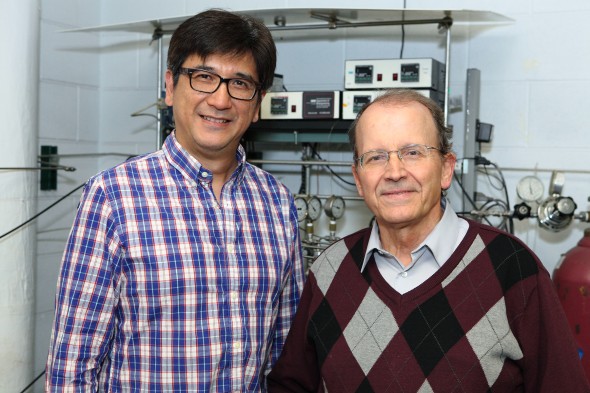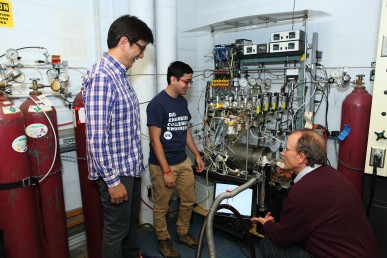East Meets West: Engineering, dentistry collaboration leads to new biomaterials

UIC researchers Cortino Sukotjo and Christos Takoudis formed their collaboration after meeting at a campus social function. (Photo: Jenny Fontaine)
Biomaterials optimally suited as scaffolds for tissue regeneration and reconstructive surgery have remained an elusive goal for material scientists and bioengineers. A collaboration between researchers in the College of Engineering and College of Dentistry has led to a breakthrough technique to improve the properties of one of the oldest — and widely used — structural biomaterials, collagen.
Collagen, the most abundant protein in mammals, has been employed as a biomaterial since sutures made from cat-gut were used to close the wounds of Roman gladiators. Strong, flexible, and unlikely to provoke an immune response, collagen membranes are used today in many medical applications, including tissue engineering, and dental bone grafting.
Seven years ago, bioengineering and chemical engineering professor Christos Takoudis met Cortino Sukotjo, an associate professor of restorative dentistry, at a campus social function.
“We realized we had common interests,” Takoudis said. “One from the clinical side, and one from the material-science and engineering side.”

“We had to work at lower and lower temperatures — until we finally got to room temperature,” says graduate student Arghya Bishal (center). (Photo: Jenny Fontaine)
Takoudis was working on atomic-layer deposition, or ALD — a workhorse technique of nanotechnology in the semiconductor industry that allows nanometer-thin layers of a metal or metal oxide to be uniformly and conformally applied to a substrate’s surface with two or three dimensional complex topography. Sukotjo was interested in improving dental implants materials. Together, could they find a way to modify and enhance the surface properties of a biological substrate? It would be Takoudis’s first foray into biomaterials.
They imagined that the biocompatibility and bioactivity of commercially available collagen membranes could be improved by coating them with an ultrathin layer of titanium dioxide, a compound widely used in cosmetics, sunscreens, food additives and dental/orthopaedic implants. They envisioned using the ALD process to apply a nanolayer of the metal oxide to these complex nanostructured membranes.
But the challenge is that biological materials like collagen cannot withstand the heat of industrial ALD treatment — often higher than 200 degrees Celsius, or nearly 400 degrees Fahrenheit.
“Seventy degrees ‘C’ is the lowest others had gotten, especially for the ALD process of Titanium dioxide on biological fibrous substrate,” said Arghya Bishal, a doctoral student in the Richard and Loan Hill Department of Bioengineering, who is first author on a paper published earlier this year in the Journal of Vacuum Science & Technology A.
“We had to work at lower and lower temperatures — until we finally got to room temperature ALD of titanium dioxide.”
The surprising achievement of room-temperature ALD was reached using a custom apparatus the researchers devised, and a new bit of chemistry: tetrakis(dimethylamido)titanium as the titanium metal source, and ozone as the oxidizing agent, to generate titanium dioxide. The two components were introduced one after the other — with an argon purge in between — into a low-pressure chamber that held the collagen-membrane ALD substrate. The researchers repeated the ALD cycle 150, 300 and 600 times to grow titanium oxide films of increasing thicknesses that could each be compared to uncoated collagen membranes.
The researchers now plan to begin pre-clinical in vivo experiments, Sukotjo said, and try to create or modify new materials using other metals and/or ALD metal oxides to cater to the specific needs of different clinical applications.
